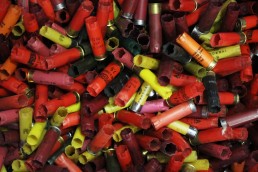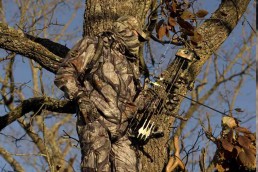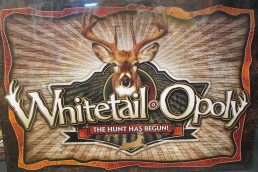Shooting Clays
SHARE THIS POST
I will never forget the first time I had the opportunity to nervously say “pull” and hear the sound of the spring on the thrower rapidly hurling that little clay disk through the air. To be honest, I can’t be sure if I was more nervous about missing or having my friends make fun of me if I did miss. Either way, I hit that first pigeon. For those of you that have been there, I missed the next nine. Fast forward a bunch of years and I had the opportunity to relive that same mix of excitement and fear with all four of my own kids and countless numbers of new shooters.
There is something magical about shooting clay pigeons with kids. I am not sure if it is the anticipation, the excitement when they hit their first pigeon or maybe it is the confidence and pride they have after each shot. Whatever it is, it is a lot of fun when done right and is an important building block to raising kids in the outdoors.
Groundwork first
The key to shooting with your kids, however, starts long before you go out to shoot the first time. There are some basic life principals and mindsets that you need to instill in them before you pull out the guns. The short list is: teaching them how to trust, understanding that there are absolutes, responsibilities and stopping without questioning why. I covered these in detail in my January article titled “Teaching the Outdoors at Home”. When you are raising kids, what you need to understand is their abilities and limitations and work with them at their own pace, giving them responsibility as they earn it. Remember, no one can be responsible without the freedom to make their own decisions. Responsibility doesn’t come with age, it comes with experience. This is another reason why I love shooting pigeons with my kids. It’s a simple way to have all the needed control to teach them step by step and convert that control to responsibility. This builds confidence in both kids and in parents as well.
A low-cost activity
Now it’s time to start shooting. The other thing that is nice about shooting pigeons is that it is still relatively inexpensive. Whether you go to a range or put together your own se up, you’re not sinking a ton of money into the experience. You can get into a good thrower for under $50 and pigeons and shells are still about eight to ten dollars per 25 rounds. This past summer, we started going to a nearby gun range with some friends. This is a great option if you are learning to shoot clays yourself or your kids are to the point where they need to have what you’re teaching reinforced by an outside authority.
My kids were shooting at the range for about the same cost as when we shoot on our own. I recommend just stopping in and asking for a tour with your kids and check out the rules and cost and plan an outing with the folks at the range. Any good range will be welcoming and excited to help teach your kids.
Are you enjoying this post?
You can be among the first to get the latest info on where to go, what to use and how to use it!
Go heavy
Picking the right gun for kids is tougher than you may think and easier than many make it. It’s important to pick a gun that fits well and is not too light. Yep, not too light. The lighter the gun, the more kick the gun has. Having a gun that has a heavy kick with a new shooter is the fastest way to give them a flinch for years of their life. I have seen many kids get kicked by a lightweight gun and never want to shoot again. I never truly appreciated this until I helped sight in a friend’s light, youth-model 30-06. I have never hurt so badly after being kicked by that tiny little gun.
I like to get a gun that is light enough for them to hold up but heavy enough to minimize the kick. Shorter barrels and heavier stocks helped with the balance with my kids. Next, it is conventional wisdom to start with a .410 which is easy to shoot as far as weight and kick. A mentor of mine gave this advice when I was picking a gun for my kids to start shooting pigeons with. “Get the heaviest 20 gauge you can, unless they can hold a 12 gauge” he said.
I, like you reading this, said “whhyyy?” He explained to me that it is all about the number of shot in the air. A .410 takes the most amount of skill to shoot. Anyone can hit a pigeon with a 12 gauge. Sure enough, he was right. I still can’t hit a pigeon with a .410, but do pretty well with the old 12 gauge that I bought when I was 12 years old. The most important thing to remember about picking out a gun for kids to start to shoot with is that they need to be comfortable and confident with it when they pull the trigger.
Thrower thoughts
When it comes to throwers, I like to stay away from hand throwers when I am out with kids. They are cheap and easy to toss into the truck, but take away from your ability to work side by side with your kids while shooting. With an inexpensive mechanical thrower, you can consistently throw pigeons one specific way and work on that shot. Once you get that shot down, you can work on the next shot. I use a marker or fingernail polish to replicate throws from one shot to the next. I have seen some people use electrical tape. My goal is to have the kids start with a familiar shot to gain confidence, then work on the shots they struggle with. This is not a bad routine for us as adults as well.
The thing that I appreciate the most about shooting clays with kids is the endless lessons we learn as a family gathered around that thrower. We get to learn competition, encouragement, coordination, and respect, to just get started. There is one principle or mindset that helps make these lessons possible, but more importantly ensures a positive experience and leads to safe outdoors excursions for life and that is “Slow and Steady”. As adults, we need to live slow and steady so we can teach it to our kids. Mistakes happen when we get in a hurry. When we are using firearms, simple mistakes can have harsh consequences. Shooting during the summer, slow and steady, makes for memorable days of learning lessons as a family. The benefits to these lessons will be evident in the field this fall and for the rest of life.
MWO
SHARE THIS POST
Did you enjoy this post?
You can be among the first to get the latest info on where to go, what to use and how to use it!
Geremy Olson
Geremy Olson grew up in the outdoors. After being burned as a volunteer firefighter, he had to figure out how to teach outdoor skills to his children from a wheelchair while learning to walk. Today he is an inspirational speaker, FCA Outdoors volunteer, tournament director, video producer, wildfire consultant and proud father of the owners of Missouri Secrets Tackle. GOspeaks.live.



